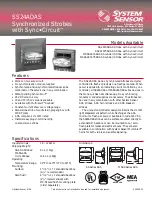
16
Commissioning
Fire detection and extinguishant system
Chapter 3
Commissioning
The commissioning phase is a set of tests and inspections which are necessary to ensure the full efficiency and proper
functioning of the system as specified in the system project. This phase is essential and must be performed in a
scrupulous way in accordance the regulatory requirements of the country where the system is installed and in full
respect of the recommendations in the following section.
Ensure the test and inspection procedures are performed only after checking the safety of the system and after having
verified that any device activations controlled by the system will not cause any conditions of danger, and that all the
building occupants who can be reached by the audible and visual signalling have been informed.
Ensure that the person who is responsible for the security of the building where the tests and inspections are to be
carried out has taken countermeasures to avoid any situations of panic or distress for the building occupants.
3.1
Testing the Control panel
It is necessary to check the functionality status of the frontplate by first checking the information supplied on the screen
and LEDs and then by inspecting the efficiency of the command devices (user-interface buttons, access keys, etc.):
• Check the functionality status of the screen and ensure that the information provided is clear.
• Ensure that the descriptions of the various zones, points and system elements entered during the data-entry phase are
correct, and that the information provided on the screen clearly indicates any detectable conditions of danger.
• Check that there are no indications present of faults, alarms or anomalies of any type whatsoever. In the event of such
indications, proceed with the removal of the causes of faults and anomalies.
• Check the status the functionality of the LEDs and buzzer. The front panel provides a button for the simultaneous
activation of all the LEDs and buzzer thus allowing evaluation of their efficiency (refer to the description of the User
Interface).
• Check the efficiency of the front-plate buttons and keys.
• Check the status of the power-supply sources (mains and batteries) and the consumption conditions of the control
panel. The power-supply parameters can be checked by accessing the configuration menu (refer to
paragraph 2.3
Accessing the configuration menu
) and selecting the configured IFM24160 modules.
The sections show the voltages, currents and temperatures of the various elements:
[A]
Button for addressing the
module
[B]
Section containing a list of
current faults
[C]
Voltage and output current
of the IFM24160 module
[D]
Battery parameters (internal
resistance, voltage, status
and current)
[E]
Internal temperature and
battery charge voltages
Low battery voltage
Mains fault
PSU 1 Module
Change address
Exit
27.0 V
0.225 A
150 mOhm
26.2 V
28°C
Charging
0.222 A
33°C
37°C
27.2 V
Esc
Access
level:3
01/01/2020
18:23
B
A
C
E
D
Содержание PREVIDIA MAX
Страница 4: ...4 Table of contents Fire detection and extinguishant system...
Страница 19: ...Configuration manual 19...

























